The previous day we'd crossed over near Londonderry aka Derry into Northern Ireland, a different country politically, as it was part of the United Kingdom, and culturally because of its combination of Irish, Scottish and English influences. One sixth of the island of Ireland, by the way, is taken up by Northern Ireland, which is only about a dozen miles from Scotland at the narrowest point. It's bordered on the south, west and also part of the north by the Republic of Ireland. The 2016 British referendum vote to leave the European Union may change the way the crossing between the Republic and Northern Ireland will be handled in the not too distant future as negotiations are ongoing as I write this.
A generation ago, Northern Ireland wouldn't have been an area tourists wanted to come to because of its decades-long political strife and violence referred to as the Troubles. We'd read that its population was still segregated along cultural, religious and political lines and that cities were divided between neighborhoods who were Unionist Protestants - those more closely allied with Britain - and Nationalist Catholics - who wanted all 32 of Ireland's counties to be united in one Irish nation. How sad to learn that early in life, locals learn to identify the two groups through colors, names, accents, music and even vocabulary.
Though Derry is now a calm city, it was a flash point of sectarian Troubles. To get a sense of the town's history, we embarked on a walk of its Walls which were built from 1613-1618 and were still intact except for wider gates to allow for modern vehicles. It was at the walls in 1688 that a group of boys, some of whom had been shipped to Derry following the Great Fire of London in 1666, made their stand. They closed the city gates to stop the approaching Catholic troops of deposed King James II to motivate the Protestant defenders inside the walls. During the ensuing 105-day siege, a third of the 20,000 people inside the walls died.
Magazine St. got its name from the ammunition store. The street now consisted of late Georgian townhouses and warehouses, mostly built in the mid-19th century.
First Derry Presbyterian Church was the second church on the site; the first was built by Queen Mary in the 1690s to thank the Presbyterian community for supporting the Anglican community during the tough days of the siege.
From the early 18th century, clubs in Derry have celebrated the role of the 13 apprentices who locked the city gates. The Apprentice Boys Memorial Hall, built in 1873, was an all-male Protestant organization and the headquarters for the Associated Clubs of the Apprentice Boys of Derry. The society celebrates the end of the siege each August with a march on the city walls as the walls are considered holy ground for devout Unionists who believe many who died during the famous siege were laid to rest within the walls because of lack of space.
The section of the wall between Royal and Double Bastion was called the Grand Parade as it was a fashionable place to walk.
Royal Bastion was one of eight surviving bastions or gun platform which projected out from the Walls to give a wider area to shoot at. It was given the name Royal Bastion during the siege because a crimson flag was flown from it.
Columba the Scribe
Three hundred churches he founded;
Three hundred were close by the sea;
And Columba, as well as the churches,
Three hundred good books, wrote he.
Double Bastion was an especially important defensive position because of its corner position as it provided cover along two stretches of walls. The old cannon was called Roaring Meg for its firepower during the siege. It took up to six men to fire the large canon that weighed 1,794 kilos!
Bishop's Gate probably acquired its name because of its proximity to the Bishop's Palace within the walls. Bishop's Gate was where James II demanded entry to the city during the siege. It was also the site of another British Army surveillance tower and overlooked the neighborhood until 2006. A view of Bishop's Gate from 'without' or outside the walls:
The head facing outwards was the River Foyle; the date 1689 and the ship breaking the boom represented the end of the siege.
View from Bishop Gate back toward the Verbal Arts School:
The view from 'within' or inside the walls:
Bloody Sunday was the day when a massive British military operation on January 30, 1972, in Derry's Bogside neighborhood ended in the murder of 13 unarmed civil rights demonstrators and the wounding of 15 others, one of whom later died. The British army labeled the victims as gunmen and bombers. They claimed their soldiers had received a "fusillade of fire" but no soldier or vehicle was hit. The Derry coroner later declared the killings "sheer, unadulterated murder" and hundreds of civilian eyewitnesses agreed.
The unnamed mural depicted Nelson Mandela and famous IRA sympathizer and hunger striker Bobby Sands on a home.
Some historical background: After Ireland was partitioned in 1921, the Unionist Party set about creating a "Protestant state for a Protestant people." Derry became the starkest example of anti-Catholic discrimination in the North, with the local government system manipulated to ensure that the Unionist minority in the city kept political power over the Nationalist majority. By the 1960s, oppressed people across the world began to demand civil rights and Derry residents noted these struggles for justice, especially in the US.
People took to the streets in Derry demanding 'one man one vote' and an end to all forms of discrimination in housing, voting and jobs. But peaceful demonstrations were met with violence from the Unionist government. While many of the demands of the civil rights movement were conceded in 1969, it was too little too late, and by that August, the north of Ireland was about to change forever.
The Civil Rights mural showed a marching Derry crowd carrying an anti-sectarian banner. It captured the mood of a typical civil rights march in the years up to 1972. Inspired by the civil disobedience campaign of Martin Luther King Jr., young and old, Catholics and Protestants, politicians and mothers took to the streets to march for their democratic rights. Civil rights marches gave this long-suffering Derry community a powerful new voice. The artists stated their intention with the mural was to "describe it as it was, a happy, almost festive occasion conducted by people who were content that they were standing up, at long last, against prolonged injustice."
When we spotted The Saturday Matinee, we immediately thought of the famous Tiananmen Square photo of a sole Chines man facing a tank. This showed a local youth behind a screen shield holding a stone he was ready to throw while a British armored vehicle approached. The mural was called Saturday Matinee because that was the day people were off work and school and therefore the best time for locals to participate in a little 'recreational rioting.'
The Hunger Strikers, repainted in 2015, featured two of the 1981 Maze Prison hunger strikers as well as their Derry mothers who supported them in their fatal decision. Ten strikers died. The prison was closed in 2000 after the release of both Unionist and Nationalist prisoners.
The stone obelisk in the fenced-off Bloody Sunday Monument listed the names of the 14 people who died, most within just 50 yards of the monument, on that tragic day in 1972.
The beautifully done murals with a range of subjects and historical moments were a daunting reminder of what happened in the Bogside area of Derry not so long ago. They told a very moving story. We could only hope the murals will forever remind us of past times and events never to be repeated again so that the past cannot be forgotten. Even though some of the murals portrayed violence, heartbreak, and sadness, in the end, I felt hope as the murals were an amazing memorial.
The pedestrian Peace Bridge that opened in 2011 linked neighborhoods that had been long divided by the River Foyle with Catholic Nationalists on the west bank and Protestant Unionists on the east bank.
Shipquay Place was the site of the huge parade ground for the former Ebrington Barracks British Army base from 1841-2003.
A generation ago, Northern Ireland wouldn't have been an area tourists wanted to come to because of its decades-long political strife and violence referred to as the Troubles. We'd read that its population was still segregated along cultural, religious and political lines and that cities were divided between neighborhoods who were Unionist Protestants - those more closely allied with Britain - and Nationalist Catholics - who wanted all 32 of Ireland's counties to be united in one Irish nation. How sad to learn that early in life, locals learn to identify the two groups through colors, names, accents, music and even vocabulary.
Though Derry is now a calm city, it was a flash point of sectarian Troubles. To get a sense of the town's history, we embarked on a walk of its Walls which were built from 1613-1618 and were still intact except for wider gates to allow for modern vehicles. It was at the walls in 1688 that a group of boys, some of whom had been shipped to Derry following the Great Fire of London in 1666, made their stand. They closed the city gates to stop the approaching Catholic troops of deposed King James II to motivate the Protestant defenders inside the walls. During the ensuing 105-day siege, a third of the 20,000 people inside the walls died.
Derry has the most complete circuit of historic walls of any town or city in Ireland. They stand up to 26 ft and measure almost one mile around. Magazine Gate, the city's newest gate, was built in 1864.
Butcher Gate was named from the slaughter houses and butchers' shops that were located on the street within the Walls during the 17th and 18th centuries. Outside the Walls was Tanner's Row that reflected the old leather trade and Cow Bog and the Beast Market! Butcher Gate and the Walls were almost doubled in height when they were rebuilt from 1805-1808 to allow better access into the city.
The section of the wall between Royal and Double Bastion was called the Grand Parade as it was a fashionable place to walk.
As we poked our heads through the fence we spotted this massive mural way down the hill in an area called the Bogside. More on that a bit later.
Along the Grand Parade were 14 sycamore trees, one for each of the 13 boys in the siege and one for James Morrison, their lookout one one of the gates. The seed of the sycamore, similar to bunches of keys, are supposed to resemble the keys with which the apprentices locked the gates.
People have worshipped at St. Augustine's Chapel for over 1400 years. According to tradition, St. Columba or St. Colmcille as he's known in Gaelic, built a monastery here in the 6th century. The small church on the walls is a venue for civic cultural events as well as still being a place of worship. Colmcille, which means dove of the church, was born of royal parentage in County Donegal in 522. After completing his studies, his cousin and king gave him property and Columba chose a clearing in the middle of an oak grove.
Three hundred churches he founded;
Three hundred were close by the sea;
And Columba, as well as the churches,
Three hundred good books, wrote he.
The graveyard had some of the oldest graves within the city walls.
Further on was a long wall that was all that was left of the British Army Base which remained until 2006. Two 50-foot towers with cameras and listening devices were built for close views of the once turbulent Catholic Bogside area below the walls. Travel writer Rick Steves wrote that the towers' dismantling and the removal of most British troops from Northern Ireland was a positive sign in Derry.
At the bottom of the hill was the Bogside area, so named because Derry was once an island but the River Foyle changed its course and the area below the wall began to drain leaving the soggy bog side of the city. That was where Catholic peasants from rural County Donegal moved into Derry to find work during the Industrial Revolution. More massive murals were barely visible on the Bogside.
The attractive brick, former Presbyterian school was the new Verbal Arts Center whose aim was to promote the development of local literary arts through poetry, writing, drama and storytelling.
The head facing outwards was the River Foyle; the date 1689 and the ship breaking the boom represented the end of the siege.
When the Troubles began almost 50 years ago, 20,000 Protestants lived on this side of the River Foyle. But this small housing development of 1,000 was all that was left as the others moved across the river to the mostly Protestant Waterside district.
View back to the Walls as we walked down the hill toward the Bogside, the Catholic area that was the tinderbox of the modern Troubles in Northern Ireland. I am sure you also remember hearing years ago about Bloody Sunday, a terrible confrontation during a march that sparked "a sectarian inferno, and the ashes have not yet cooled."
At the public inquiry announced by the British government a couple of days later, Lord Chief Justice Widgery refused to take evidence from the vast majority of civilian eye witnesses and soldiers testified anonymously and in disguise. It was later revealed that their statements were altered to suit the British version of events. After the army was exonerated, it confirmed for Free Derry the entire British establishment stood behind the Bloody Sunday killers. After a relentless campaign by the victims' families, a new inquiry was established on the 20th anniversary and its report was published just nine years ago. Its main conclusion that all of the dead and wounded had been innocent was greeted with huge applause and profound relief in Derry.
The 12 Bogside Murals give visitors a glimpse of this community's passionate perception of Bloody Sunday. They were painted to memorialize the events and located on the ends of low-rise residential apartments on two streets where the march occurred. Two brothers, Tom and William Kelly, and their friend, Kevin Hasson, known as the Bogside Artists, grew up in the neighborhood and witnessed the tragic events of Bloody Sunday. That led them in 1994 to begin painting the murals.
The circle of male faces known as the Bloody Sunday Commemoration, was painted in 1997 to pay tribute to the 25th anniversary of the tragedy and showed the 14 victims surrounded by a ring of oak leaves which was the symbol of Derry. The images were pretty accurate because relatives discovered the artists wanted to portray the victims and therefore lent precious photos of their loved ones. Bullet holes were still visible in the mural.
The unnamed mural depicted Nelson Mandela and famous IRA sympathizer and hunger striker Bobby Sands on a home.
The Death of Innocence showed a teenage girl, Annette McGavigan, standing in front of bomb wreckage. Annette, the cousin of one of the artists was killed in crossfire on this corner in 1971. She was the 1,000th fatality of the Troubles which ended up resulting in more than 3,000 lives. The large butterfly over Annette's shoulder represented the hope for peace. For years, the butterfly was left in silhouette by the artists until they felt assured the peace process had succeeded. The butterfly was finally filled with optimistic colors in 2006.
I felt somewhat uneasy strolling along the street to view the many murals as if I were intruding, even knowing the residents had to be used to the constant stream of tourists also gazing at what seemed like an outdoor art gallery and history museum.
One of the more shocking murals was Petrol Bomber which displayed another teen sporting an army-surplus gas mask as he and other locals barricaded their community during the Battle of the Bogside which effectively shut out the British forces. In the background was the former Rossville Flats housing project with the Irish tricolor flag flying from the top..
On the end of another building was the mural called Bernadette. The woman with the megaphone was Bernadette Devlin McAliskey, a civil rights leader who became the youngest elected member of Parliament at just 21. Look at the kneeling woman behind her banging a garbage can lid - that was used to warn neighbors of approaching British patrols.
In early January, 1969, after a night of rioting and sustained police attacks on the Bogside, the words "You are now entering Free Derry" were painted on a wall at the end of a median strip called Free Derry Corner. This simple graffiti became the defining symbol of the civil rights era and an internationally recognized symbol of resistance to state injustice. The words imitated a similar slogan in West Berlin when it was isolated. During the Troubles, this was the go-to meeting place for speakers to address crowds.
The mural on the corner has changed often over time reflecting issues of concern and injustices suffered by others, particularly Palestinians and Basques. When we were there, its message dealt with climate change. We'd noticed earlier lots of black, white and green Palestinian flags and signs because Catholic residents of Northern Ireland and Palestinians had an affinity for each other as both were indigenous people forced to deal with sharing what they considered their rightful homeland with more powerful settlers who had been settled there for political reasons.
On the other side of the street was the Bloody Sunday mural showing a a group of men carrying a body from the march. It was based on a photo of Father Edward Daly taken that day of his waving a white handkerchief so he could request safe passage while carrying a seriously wounded protester.
On another median strip was a large granite letter 'H' marked with the names of the ten IRA hunger strikers who died and the number of days they starved in the H-block of Maze Prison in 1981. The Hunger Strike Memorial was unveiled on May 5, 2001, the twentieth anniversary of the death of Bobby Sands, one of the hunger strikers who sought political status.
The Runners featured three rioting youth fleeing tear gas from the more than 1,000 canisters used by the British Army to disperse hostile crowds during the Battle of the Bogside. Supposedly 'non-lethal' rubber bullets killed 17 residents during the Troubles.
Motorman depicted the period when Free Derry ended at 4 am on July 30th, 1972, when thousands of British troops in tanks and armored cars invaded the Bogside and Creggan 'no-go' areas. During Operation Motorman, they tore down the barricades with bulldozers. The artists chose the image of a soldier bulldozing down a door to express the sheer ferocity of the onslaught. With its contrasting light and shadow, the mural has become a powerful statement against war.
The Civil Rights mural showed a marching Derry crowd carrying an anti-sectarian banner. It captured the mood of a typical civil rights march in the years up to 1972. Inspired by the civil disobedience campaign of Martin Luther King Jr., young and old, Catholics and Protestants, politicians and mothers took to the streets to march for their democratic rights. Civil rights marches gave this long-suffering Derry community a powerful new voice. The artists stated their intention with the mural was to "describe it as it was, a happy, almost festive occasion conducted by people who were content that they were standing up, at long last, against prolonged injustice."
In front of the mural was a Garden of Reflection that paid homage to the people's priest, the late Bishop of Derry, Dr. Edward Daly. He was thanked for the work he did for the people of Derry and beyond. I thought the tribute was especially powerful:
To love means,
Loving the unlovable,
To forgive means,
Forgiving the unforgivable,
Faith means,
Believing the unbelievable,
Hope means, Hoping when
Everything seems hopeless.
The colorful Peace mural depicted a dove in silhouette. On the right side was an oak leaf. The mural came about after a peace campaign asked Derry schoolchildren to come up with suggestions for peacetime images. As the dove was a traditional symbol of peace and the oak leaf was a traditional symbol of Derry, each was recognized by both Catholic and Protestant communities. I liked how the dove was flying from the sad blue of the past toward the brighter yellow of the future.
It was difficult to find the John Hume mural as it was located out of the way above a ramp. It was a collection of four faces: clockwise from the upper left was John Hume, the Nationalist leader, Martin Luther King Jr., Nelson Mandela and Mother Teresa. In the lower middle was Brooklyn Bridge which represented the bridges of understanding created by the four Nobel-prize winners.
Andrew and Paul: You both would have been interested seeing these posters publicizing the upcoming Climate Change demonstrations.
As we walked toward the center, we felt like we were home again seeing the billboard for our local Coors Beer!
The flowers in a roundabout were in the shape of the city walls.
The Neo-Gothic Guildhall that opened in 1890 was the ceremonial seat of city government built on reclaimed lands that were once the river's mudflats. The building was greatly damaged by IRA bombs in 1972. Ironically Gerry Doherty, one of those convicted of the bombings, was elected as a member of the Derry City Council twelve years later! We only spent a few minutes admiring the entry and the stained-glass windows showing signs of Derry history.
Next post: Later that day we headed toward beautiful Malin Head, the northernmost spot in Ireland, that, oddly enough, was actually in the Republic of Ireland and not in Northern Ireland!
Posted on October 21st, 2019, on a lovely fall day in Denver after enjoying a fun weekend with George and Cay, our son's in-laws from Maine.
















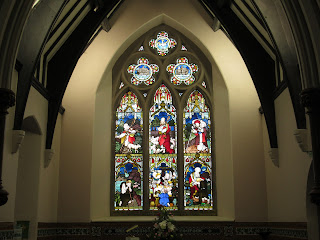








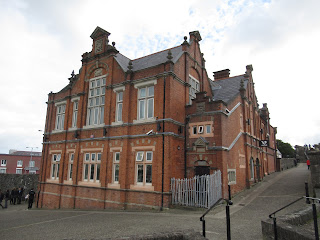


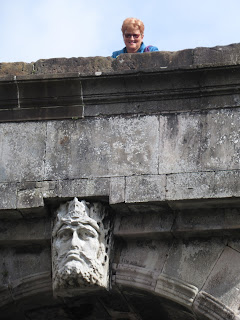






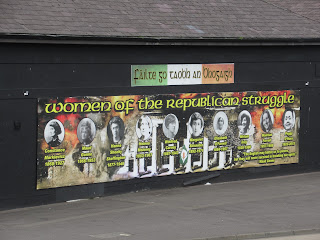














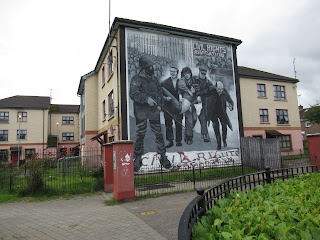





























It's so important to remind us of the "bloody" history of Northern Ireland; hopefully by remembering we will not let history repeat itself... and thanks for the inspiring poem that I will keep close to my heart..
ReplyDeleteTo love means,Loving the unlovable,To forgive means, Forgiving the unforgivable,
Faith means, Believing the unbelievable, Hope means, Hoping when Everything seems hopeless.
xo Lina